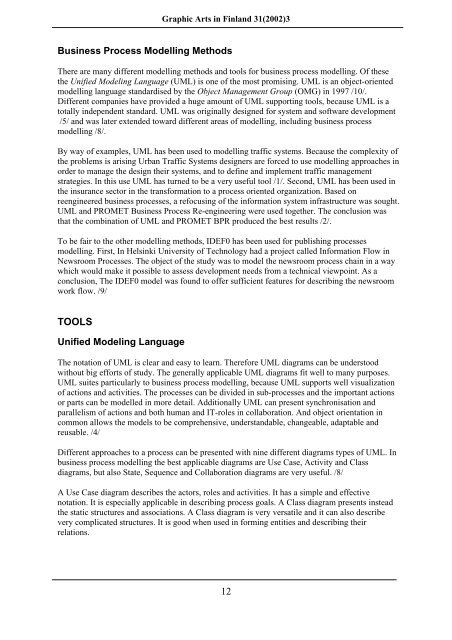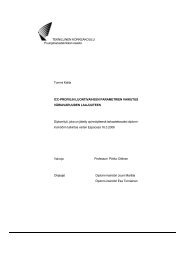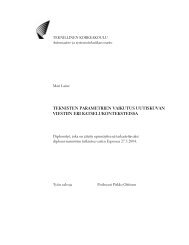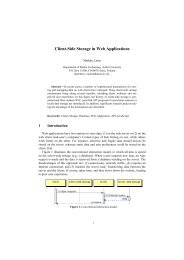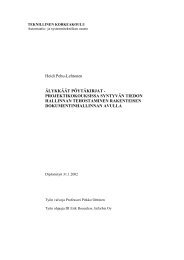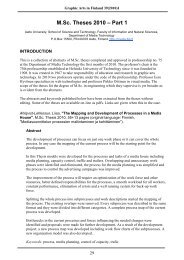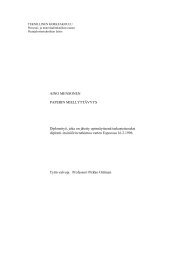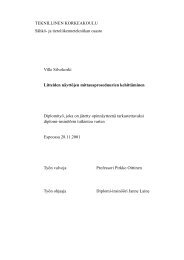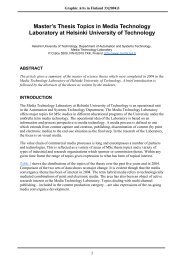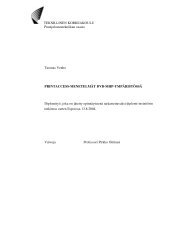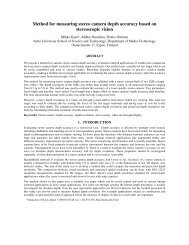Modelling of publishing processing with UML - CiteSeerX
Modelling of publishing processing with UML - CiteSeerX
Modelling of publishing processing with UML - CiteSeerX
Create successful ePaper yourself
Turn your PDF publications into a flip-book with our unique Google optimized e-Paper software.
Graphic Arts in Finland 3 1 (200 2) 3Business Process <strong>Modelling</strong> MethodsThere are many different modelling methods and tools for business process modelling. Of thesethe Unified Modeling Language (<strong>UML</strong>) is one <strong>of</strong> the most promising. <strong>UML</strong> is an object- orientedmodelling language standardised by the Object Management Group (OMG) in 1997 /10/.Different companies have provided a huge amount <strong>of</strong> <strong>UML</strong> supporting tools, because <strong>UML</strong> is atotally independent stan dard. <strong>UML</strong> was originally designed for system and s<strong>of</strong>tware development/5/ and was later extended toward different areas <strong>of</strong> modelling, including business processmodelling /8/.By way <strong>of</strong> examples, <strong>UML</strong> has been used to modelling traffic systems. Because the complexity <strong>of</strong>the problems is arising Urban Traffic Systems designers are forced to use modelling approaches inorder to manage the design their systems, and to define and implement traffic managementstrategies. In this use <strong>UML</strong> has turned to be a very useful tool /1/. Second, <strong>UML</strong> has been used inthe insurance sector in the transformation to a process oriented organization. Based onreengineered business processes, a refocusing <strong>of</strong> the information system infrastructure was sought.<strong>UML</strong> and PROMET Business Process Re- engineering were used together. The conclusion wasthat the combination <strong>of</strong> <strong>UML</strong> and PROMET BPR produced the best results /2/.To be fair to the other modelling methods, IDEF0 has been used for <strong>publishing</strong> processesmodelling. First, In Helsin ki University <strong>of</strong> Technology had a project called Information Flow inNewsroom Processes. The object <strong>of</strong> the study was to model the newsroom process chain in a waywhich would make it possible to assess development needs from a technical viewpoint. As ac o n clusion, The IDEF0 model was found to <strong>of</strong>fer sufficient features for describing the newsroomwork flow. /9/TOOLSUnified Modeling LanguageThe notation <strong>of</strong> <strong>UML</strong> is clear and easy to learn. Therefore <strong>UML</strong> diagrams can be understood<strong>with</strong>out big efforts <strong>of</strong> study. The generally applicable <strong>UML</strong> diagrams fit well to many purposes.<strong>UML</strong> suites particularly to business process modelling, because <strong>UML</strong> supports well visualization<strong>of</strong> actions and activities. The processes can be divided in sub- processes and the important actionsor parts can be modelled in more detail. Additionally <strong>UML</strong> can present synchronisation andparallelism <strong>of</strong> actions and both human and IT - roles in collaboration. And object orientation incommon allows the models to be comprehensive, understandable, ch angeable, adaptable andreusable. /4/Different approaches to a process can be presented <strong>with</strong> nine different diagrams types <strong>of</strong> <strong>UML</strong>. Inbusiness process modelling the best applicable diagrams are Use Case, Activity and Classdiagrams, but also State, Sequence and Collaboration diagrams are very useful. /8/A Use Case diagram describes the actors, roles and activities. It has a simple and effectivenotation. It is especially applicable in describing process goals. A Class diagram presents insteadthe static structures and associations. A Class diagram is very versatile and it can also describevery complicated structures. It is good when used in forming entities and describing theirrelations.1 2


